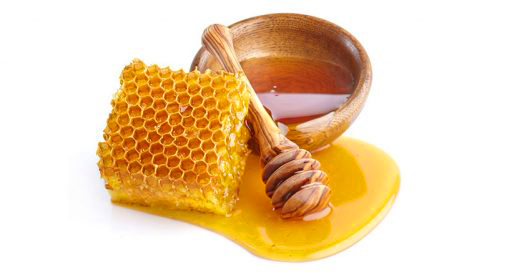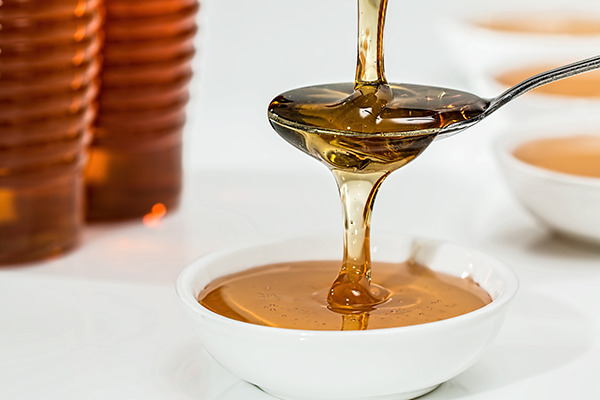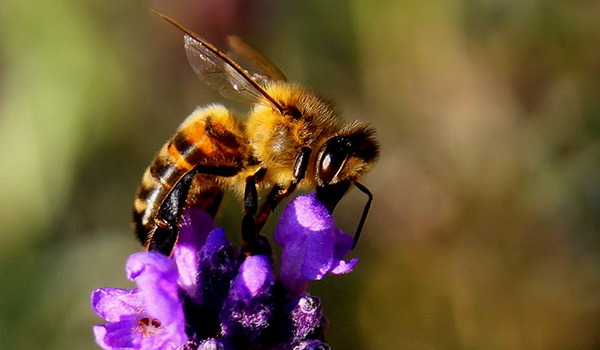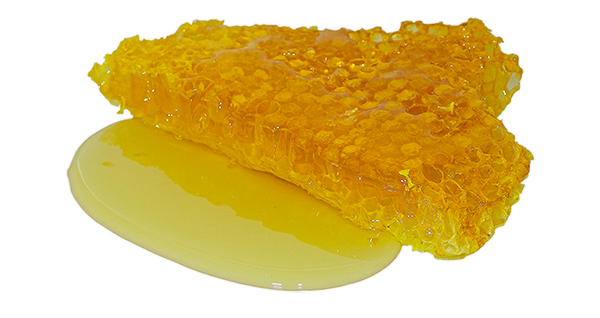In Sanskrit, honey is called Madhu, a word that also denotes “sweet, lovely, pleasant.” In German, honey is sometimes called “the golden miracle”, just one illustration how popular and prized it is in Europe as well as in India, the home of Ayurveda.

In Vedic texts, Sattva is defined as the positive, supporting principle of nature. Accordingly, Ayurveda classifies honey as a Sattvic food, because it promotes unity of body and mind. Sattvic individuals are described as truth-loving, giving generously, learned, wise, and loving. Therefore, consuming Sattvic foods like honey prolongs life and promotes a positive mindset day in day out.
“The rejuvenating measures of Ayurveda work like the nectar of immortality and even strengthen divine qualities.”
Charaka Samhita
A popular food
Since over 10,000 years, honey is known as a special delicacy giving vitality and strength. In Ayurveda, this natural sweetener is valued because it harmonizes all three Doshas; it’s also an Anupana (carrier) that enhances the effect of herbs and remedies taken with it.
Also in Germany, honey is very popular – on average, Germans consume just over a kilo of honey per person per year.
However, only one fifth of all honey is produced regionally. Most of the available honeys are mixed products, originating from EU and non-EU countries.
There are nine categories of honey, ranging from blossom honey to comb honey. These categories are further differentiated into many types of honey, varying in taste from mild and light to dark and strong. The classical Ayurveda texts, however, describe only 4 honey categories, according to their quality and effect on the physiology.
What’s inside honey
Honey consists primarily of simple sugars such as fructose and glucose. Compound sugars and oligosaccharides are contained in smaller proportions. Altogether, the carbohydrate content amounts to 80%. The rest consists of water, minerals, trace elements, vitamins, enzymes, proteins, and secondary plant substances. Over 245 natural ingredients have been detected in high-quality honeys, with the exact composition varies greatly with the flowers visited and the quality.
Honey is especially appreciated because of the secondary plant substances contained, the so-called flavonoids, which are thought to be responsible for its antibacterial and antioxidative effects, together with phenolic compounds and proteins.
Particularly Manuka Honey from New Zealand is becoming more and more popular because of its excellent healing properties. Its antibacterial effect is well-researched and recognized scientifically. Especially in vitro, Manuka Honey has shown a very good effectiveness against multi-resistant germs. As honey works on several levels, it’s difficult for bacteria to develop resistance against it.

Which honey for which Doshas?
Ayurveda uses the term Desha (“homeland”) when describing the influence of geographical factors on our physiology. It says that Desha products are particularly digestible and beneficial. Accordingly, the honey of choice should preferably be produced locally, rather than imported.
Honey with a dark color and a strong taste is considered most easily digestible and beneficial to health. Such honey is especially effective in reducing Kapha Dosha and eating away Ama. Honey with a light color and a mild taste, on the other hand, is good for harmonizing Vata and Pitta Doshas.
Besides the variety and the origin, also the honey’s age influences its effect. Ayurveda emphasizes that storing honey in the dark for over a year significantly increases its digestibility. As the honey is allowed to ripen longer, the sugars crystallize more and the enzymatic effectiveness increases, which in turn enhances its Kapha-reducing quality.
These are the marks of high-quality honey:
- Sufficient degree of ripeness (low water content of maximum 18 percent);
- No heating above 40°C during production
- No fine filtering;
- Having a certified organic label, e.g. Demeter quality.
- High-quality, natural honey becomes solid after some time.
Why organic honey?
People often ask: “Isn’t all honey organic?”
No! Conventional honey is harvested by bees that also fly to conventional fields, so they mostly visit plants treated with pesticides. This is neither a good thing for people nor for bees, and the environment suffers as well. Organic bee colonies, on the other hand, are located near fields with organic agriculture produce or on untreated meadows with a wide variety of plants.
Furthermore, for organic honey it’s not allowed to treat the bees with synthetic agents and medicines, and therefore their honey contains less residues. Organic beekeepers take care of their colonies with natural building materials and natural care products. One more reason to prefer organic honey and organic food.

Honey reduces Kapha
Kapha is the Dosha characterized by the following qualities: heavy, oily, slow.
Generally, when Kapha Dosha is increased, one should eat less sweet food. Only honey may still be enjoyed – although not in excess – because honey contains many Kapha-reducing substances. It also stimulates the digestive fire Agni and the metabolism. This is especially true of honey that has been harvested a year or more ago. The older the honey, the higher its fat-burning and Kapha-reducing effect. Young honey, on the other hand, is just a source of pure energy without a Kapha-reducing effect.
For weight reduction, Ayurveda recommends drinking a glass of lukewarm water with a teaspoon of honey (preferably slightly older) stirred in before and after meals. This can increase the burning of fat.
Do not heat above 40 °C
Please do not heat honey above 40 °C, because the heat destroys the ferments, and in addition, substances are formed which are difficult to digest and become Ama (unexcreted residues of metabolism). Ama, in turn, is almost always a contributing cause of diseases of all kinds. Contrary to many supposedly “healthy” recipes, honey should not be used for baking or cooking, because when heated to over 40 degrees, honey loses its health-promoting effect. According to German honey regulations, it’s not allowed to sell honey that has been heated to above 40 degrees under the name “honey”. So to sweeten your tea, it’s better to use Sharkara (Ayurvedic cane sugar) or regular cane sugar.
Honey – the food of the gods
Honey has the wonderful property that it balances all three Doshas: especially Kapha, but also Vata and Pitta Doshas settle down with the consumption of honey.
Honey, like milk, is a natural Rasayana. It contains many vitamins, minerals (magnesium, calcium, potassium) and trace elements. Just like milk and Ghee, honey is an ideal carrier for Ayurvedic medicinal substances – it acts as a catalyst and enhances their healing effect.
With mucus-forming colds and coughs, honey helps if taken stirred into lukewarm milk (maximum 40 °C). Prepare the milk by adding the same amount of water, then boiling it down to the original amount. After cooling down to below 40 degrees, stir a teaspoon of honey into the milk and enjoy this expectorant and tonic drink.
Other ways to use honey
Lemon water in the morning
After getting up, before breakfast, drink 1 to 2 glasses of warm water mixed with the juice of half a lemon and a teaspoon of honey. This “lemon water” is pleasant to the taste and supports a healthy intestinal flora, prevents flatulence, promotes bowel emptying and helps the organism to detoxify.
Strengthening the digestive fire
Shortly before each meal, take a mixture of ginger juice, honey, and fresh lemon juice (1 teaspoon each) and a pinch of salt. This is a simple way to stimulate your digestive fire, so that the food you eat afterward is digested better.

The manifold effects of honey at a glance:
- Honey strengthens the eyesight
- Honey reduces fat tissue
- Honey works as an expectorant (helps remove mucus)
- Honey harmonizes all three Doshas
- Young honey is an energy source (beneficial for Vata and Pitta)
- The older honey is, the more it has a Kapha-reducing effect
- Honey stimulates Agni, the digestive fire
- Honey supports wound healing
- Honey has an antibacterial and anti-inflammatory effect.
Download the article as a PDF file
© Maharishi AyurVeda Health Centre Bad Ems
Thank you. This information is wonderful to help spread the prevention possibilities.
I will be sharing this information on zoom very soon. As a practitioner I agree with all you say about prevention.
Thanks again,
Sue
thank you so much!!!
love you all
happy new year